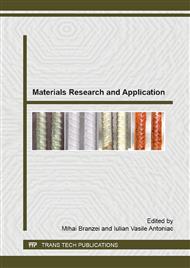p.50
p.56
p.62
p.68
p.76
p.81
p.86
p.92
p.100
Composite Materials Based on Silicone Rubber Used to Mitigation Electromagnetic Pollution
Abstract:
Rapid developments in telecommunications and digital processing of information are facing the problem of electromagnetic wave pollution and interference. The aim of this article is the characterization at microwave frequencies of composite materials based on silicone rubber. These materials contain 80% siloxane rubber and only 20% powdery feeling like nanocarbon and pyrite cinder. To achieve these objectives were reviewed and selected raw materials and characteristics were determined in a structural material, the electromagnetic attenuation as well as electrically, by making measurements of electrical conductivity of thin layers of polymer matrix composites produced by the doctor blade technique. Starting from sample siloxane rubber, i.e. without additives or filler reinforcement in compression analysis we find that reinforcing agents leads to increased values of the modulus of elasticity in especially for pyrite ashes. For materials analyzed in this paper, measurements were made in the frequency range between (1-18) GHz and have found high attenuation over 45 dB in the case of composite materials with pyrite ash filler. So we can say that this materials can used for shielding against electromagnetic waves in order to protect the human factor. The novelty of the paper consists in the compositions of the specimens and their mechanical and electromagnetic characteristics.
Info:
Periodical:
Pages:
76-80
Citation:
Online since:
July 2015
Keywords:
Price:
Сopyright:
© 2015 Trans Tech Publications Ltd. All Rights Reserved
Share:
Citation:


